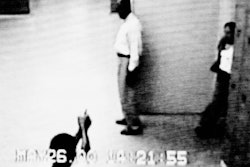Deciding who should be hired to a high-ranking position at a law enforcement agency is a difficult job, no question. And the last thing any department wants is for such decisions to be viewed as arbitrary or unfair. This is why many agencies now use a structured process that incorporates the opinions of many people within and outside the department to evaluate prospective employees.
Many police departments and sheriffs offices have recognized and begun to use assessment centers not only as a way to determine who should be hired for top-ranking positions, but also as a promotional process and a way to identify strengths and weaknesses of an agency and its employees. When properly planned and implemented, an assessment center will be viewed as a fair and objective process for making sure that the best officer is promoted. Used incorrectly, the assessment center will become stigmatized as an unrealistic and unfair process that could result in civil litigation for the agency.
The purpose of this article is to provide a layman’s nut-and-bolts approach on how to plan and conduct an assessment center. I will dispel or confirm some of the rumors you might have heard about assessment centers. Finally, I’ll leave you with some tips on conducting your first assessment center based on my 15 years of experience.
What Is An Assessment Center?
In its May 1989 publication, “Guidelines and Ethical Considerations for Center Operations,” the International Congress on Assessment Center Method endorsed the following definition of an assessment center:
“An Assessment Center consists of a standardized evaluation of behavior based on multiple inputs. Multiple trained observers and techniques are used. Judgments about behavior are made, in major part, from specifically developed assessment simulations. These judgments are pooled in a meeting among the assessors or by a statistical integration process. In an integration discussion, comprehensive accounts of behavior, and often ratings of it, are pooled. The discussion results in evaluations of the performance of the assesses on the dimensions or other variables the Assessment Center is designed to measure. Statistical combination methods should be validated in accord with professionally accepted guidelines.”
Beyond this description, there are essential elements you must include in a selection process for it to be considered an assessment center.
The first step in conducting an assessment center is analyzing the behaviors relevant to the job to be filled. These behaviors must then be classified into meaningful and relevant categories. Before beginning the process, design techniques to provide information to evaluate the identified dimensions, or standards, each candidate will be measured against.
During the evaluation process, use multiple assessments, including interviews and simulations designed to elicit a variety of behaviors and information relevant to the selected dimensions. Assessment techniques must include a sufficient number of job-related simulations to allow opportunities to observe the candidate’s behavior related to each dimension.
Have multiple assessors observe and evaluate each candidate. They all must receive thorough training and demonstrate knowledge of the dimensions, rating methodology, feedback, and other necessary skills used to conduct the assessment. Thus, they will be able to use the agreed-upon systematic procedure to record specific behavioral observations accurately at the time of their occurrence.
After an assessment has been completed, each assessor must prepare a report of the observations made during each exercise and create a group report together. The integration of behaviors—data integration—must be based on a pooling of information gathered at a meeting of all assessors.
Why Use An Assessment Center?
The question you must answer before choosing to establish an assessment center is why you are doing it. What are the benefits? Why not use some type of process such as a chief’s interview, gather seniority and discipline records, and throw them all into the mix? After all, an assessment center takes a great deal of work to plan and implement and costs more than other simpler promotion processes.
Assessment centers, although useful, are not meant to stand alone. They should really be used as one part of an overall process. Before planning an assessment center, your agency should have a clear policy and description of its promotional process, detailing what types of processes will be used including the assessment center, chief’s interview, and any other means of evaluation.
Despite the cost, time, and effort needed to conduct an assessment center, it’s still an effective way to evaluate candidates. An assessment center is unique in that it is a job-rated, multi-dimensional, multi-exercise process in which each candidate is evaluated separately.
By using a multiple-exercise process, candidates who may not perform well in one exercise such as an interview may do very well in another exercise such as an analysis and presentation exercise. This makes the process more objective because it doesn’t cater to one particular type of candidate to the exclusion of others who might be just as well, or better, suited to the job.
Laying the Groundwork
The first thing you have to do when creating an assessment center is to conduct a job analysis. This analysis is the cornerstone for your assessment center. Job analysis can be conducted through a review of an updated job description and surveys and interviews with the incumbents and supervisors. It will tell you exactly what job you’re trying to fill.
The next task is to identify the behaviors essential for the position. Typically, you’ll need to identify 12 to 14 behavioral classifications or dimensions. Dimensions are the standards you are measuring the candidates against.
Tailor the dimensions to the position and the agency. For example, if an assessment center is being conducted for a police chief in a large city, the identifying behaviors to look for are somewhat different from those for a chief’s position in a smaller community.
This is because the chief in the smaller agency performs some very different roles than his or her counterpart in the big city. One of the differences is that the small-town chief is expected to be accessible to the everyday citizens, typically without an appointment.
Also, many small-town chiefs often come out to major crime scenes and, depending on the size of the agency, may have to participate in the investigation. Another difference is the layers of management between the small-town chief and the street-level police officer. In a small department there may be two to three layers of management, while in the larger department there may be six or more layers.
Typical dimensions used to evaluate candidates in a police assessment center include oral communications, written communications, command presence, technical and professional knowledge, decision making, judgment, planning and organization, work perspective, and problem analysis.
Techniques and Simulations
Once you’ve identified the dimensions, begin work on the exercises to be used. Write the exercise scenarios so they are realistic, job related, and require the candidate to demonstrate the behaviors selected for that particular exercise.
Most of the assessment centers I conduct consist of three to four exercises testing approximately six dimensions in each exercise. This allows some dimensions to be tested in more than one exercise.
Typical exercises that fit these criteria range from basic question-and-answer sessions to very involved simulations.
On one end of the spectrum, an interview simply consists of the candidate answering a pre-prepared set of questions. Topics may include specific department policies and procedures, specific scenarios, and professional development issues.
Role-play exercise can take a variety of forms. Some sample scenarios include the candidate meeting with a citizen who wishes to file a complaint about a police officer or a police situation; the candidate meeting with the role player to discuss an evaluation or complaint; and a police situation in which the candidate must command and make decisions.
An in-basket exercise takes this one step further by simulating an entire day at the office. In this type of exercise, each candidate role-plays processing a number of documents such as memos, reports, and evaluations by sifting through the documents and preparing responses for how he or she would handle them. It is typical to introduce a number of interruptions that the candidate must handle in addition to any of the basic tasks given to him. These interruptions can include responding to phone calls or additional memos and unexpected visits from citizens and other officers.
When creating the in-basket exercise, it’s best to use a “live” in-basket in which the interruptions consist of actual role players causing the interruptions, whether it be a visit or a phone call. The advantage of the live in-basket is that it adds a greater sense of realism to the exercise.
Another option to consider in planning your in-basket is placing a written description of the interruption in a sealed envelope. At the appointed time, the test proctor will distribute the envelope to the candidates, who must immediately open the envelope and address the interruption. The advantage of using this approach is all of the candidates can take the in-basket exercise at the same time, and the exercise can be conducted before the actual dates of the assessment center.
Regardless of which method you choose, it is important that the situations be realistic. I recommend that you use actual agency letterhead, schedules, and reports in your in-basket exercise.
In the analysis and presentation exercise, the candidate is given a task several weeks before the actual assessment center and then he or she must make a presentation to the assessors when the assessment center takes place. A typical scenario might involve the candidate analyzing the agency’s pursuit policy and making recommendations for any necessary changes. As part of the presentation, the candidate will be expected to defend his or her research, conclusions, and recommendations.
In the leaderless group exercise, when candidates enter the exercise room you’ll give them a situation in which they must work together to resolve an issue or solve a problem. An option in planning this exercise may be to present the situation a day or so before the leaderless group and use the allotted time for the candidates to work toward the resolution.
Assessor Selection
Even as the exercises are being developed, you should begin obtaining your assessors. Typically, I use three assessors per exercise. Using this model, if you conduct three exercises, you’ll need nine assessors.
Choose assessors from other similar law enforcement agencies who have at least attained the rank being tested. For example, if you are planning a sergeants’ assessment center, you want your assessors to be sergeants or higher in rank. When selecting assessors you should also strive to have a diversity of age, gender, and ethnicity.
You should consider obtaining some of your assessors from the public and business community. Such an approach can pay big benefits in giving these public leaders a better understanding of the importance that the agency places on its promotional process. A second benefit of this approach is that the chief or sheriff will have a better understanding of how the candidates relate to the private sector.
Make sure that any private citizen or business leader you approach is aware of the time commitment involved. It will really gum things up if one of your assessors leaves in the middle of an exercise because he or she has an appointment.
Assessor Training
One of the first steps in the assessor training process is the creation of an assessor orientation manual, which contains the dimensions, exercises, schedule, rating methodology, and other key information that each assessor will need to know. The assessors should receive their manuals one to two weeks before the assessment center and be familiar with the manual’s contents before arriving at the assessment center.
On the day of the assessment center, the police chief or sheriff may wish to be present to greet the assessors. He or she may also wish to talk about the position that the agency is hoping to fill and the ideal attributes of an officer at that rank.
An assessor training session should be conducted before the candidates are seen. This training should, at a minimum, include a review of the assessor orientation manual and dry runs of the exercises.
Just as it is important that the assessors understand the process, it is also important that the candidate have an understanding of the assessment center process. It’s a good idea to prepare a candidate orientation manual, which contains the schedule, dimensions, and the types of exercises to be conducted, to distribute to the candidates.
Recording Behavior and Reports
After the assessor training, it is now time for the assessors to see their first candidates. Candidates systematically rotate through the various exercises. Here’s how it works.
Let’s assume that Candidates A, B, and C are participating in an assessment center consisting of three exercises: interview, role-play, and live in-basket. At the appointed time, Candidate A participates in the interview exercise, while Candidate B and Candidate C participate in role-play and live in-basket exercises, respectively.
During each exercise, the assessors observe the behavior of their particular candidate, making careful and detailed notes of their observations.
At the conclusion of the exercise the assessors complete an individual score sheet rating how each candidate meets the particular dimensions assigned to that exercise. I prefer a 10-point scale in which a score of five means that the person meets the bare minimum to meet the task. Half points—5.5, for example—are not recommended because they make scoring complex, and there’s no need for them.
Following the completion of the individual score sheets, the assessor team completes a consensus score sheet in which it must agree on a rating for each dimension using the 10-point scale. Typically, individual assessors’ score sheets are within a few points of each other. This is a good sign, indicating that the assessors came to the same conclusion.
Once the individual and consensus score sheets have been completed, the assessors sign their forms and turn in all scoring sheets and notes to the assessment center manager.
When Candidate B comes into the interview exercise, the assessors repeat the process, being careful not to compare Candidate B to Candidate A. The assessor’s job is to judge Candidate B solely on his or her performance. In the meantime, Candidate A is in one of the other two exercises, and so on.
During the assessment center process, it is important that the assessors not discuss with other assessors whom they have seen or their opinions of the candidates. It is very important that each candidate be given a fair shake in this process.
Data Integration
At the conclusion of all of the exercises, the scores are tallied and a debriefing is held. During the debriefing the chief or sheriff is invited to listen to any comments that the assessors might wish to offer about the particular candidates that have gone through the assessment center. In addition, assessors might want to discuss common trends, good or bad. The debriefing will not change any of the assessment center scores but is simply additional information.
At the conclusion of the debriefing, the assessors are excused. They are reminded their work in the assessment center should be considered confidential.
The last step is a written report describing each candidate’s performance. The report should contain the scores and a summary of the assessor notes. Specific assessor names and their associated comments should not be listed. The candidate reports and original score sheets and notes should be presented to the police chief or sheriff. Many chiefs and sheriffs will provide a copy of the candidate report to those candidates who express an interest. But original score sheets and assessor notes should not be released.
The assessment center process can be an exact predictor of how a person will actually perform on the job. To conduct a successful center, the assessment center should start small and build in complexity as the experience of those involved grows.
Michael McLaurin began his work with law enforcement as an employee of the Charlotte (North Carolina) Police Department and presently works with the Centralina Council of Governments in the Charlotte area. McLaurin, a CALEA assessor, holds a B.A. from Pfeiffer Univeristy and an M.A. from the University of North Carolina at Charlotte.
How to Run an Assessment Center
Deciding who should be hired to a high-ranking position at a law enforcement agency is a difficult job, no question. And the last thing any department wants is for such decisions to be viewed as arbitrary or unfair. This is why many agencies now use a structured process that incorporates the opinions of many people within and outside the department to evaluate prospective employees.











